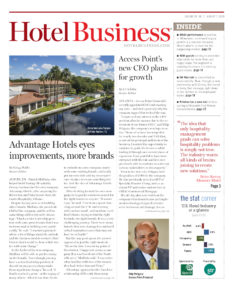LONDON—Hotel Business recently caught up with Ben Martin, principal, HKS Inc., as he highlighted some of the industry’s hottest trends. Born out of some travel fatigue and a thirst for new experiences and lodging options, here’s a look at what to expect down the road.
ARCTIC TOURISM
What it is: Increased tourism to Iceland, Greenland, Alaska and parts of Russia. It’s grown out of increased awareness of the natural environment and culture. It crosses all different types of travelers—luxury, bucket-list destinations, authentic and connected-to-nature experiences.
How the industry should respond: “There is a commercial opportunity here,” Martin said. “It’s a place that not many of us have experienced. It’s the flip side to increased urbanization. There are two types of arctic experiences: winter wonderland—husky treks or seeing the Northern Lights, or more rugged—seeing whales, sea eagles, polar bears or even going arctic surfing.”
Where it’s headed: “People want to go here, but there’s a desperate requirement for sensitivity,” he added. “The hotel development sector needs to think carefully about how they’re approaching this. There’s not a lot of product up there today. Architects need to realize the connection with nature is important—large windows, glass roofs, drawing from local vernacular, natural materials. All of the main operators—and certainly the luxury ones—will most likely have something in their portfolio in the Arctic in the next decade, if not in the next five years.”
BRANDED RESIDENTIAL
What it is: Properties sold with a hotel brand alongside or associated with it. Around since the 1920s, it has gained popularity in the last 10-15 years. Martin said, “85% of branded residences are with a hotel. They’re typically in an urban environment (75%). In urban areas, you know where your buyers are. It’s more challenging in a resort because you don’t have your buyer pool on your doorstep… They often have a rental pool associated with them, which allows them to be rented out to people who want to stay in the hotel when they’re not being used by the owner.”
How the industry should respond: “They can radically enhance the viability of a luxury hotel project,” Martin said. “Hotels, if they’re developed to a high standard, are very expensive to build and can take many years to make any kind of return. If you’re able to sell a number of residential units, people are paying for those upfront; that helps the cash flow profile.”
Where it’s headed: “We are seeing non-hotel brands coming into the market, and they’re going to shake things up, like with Aston Martin and Porsche,” he predicted. “There are plenty of other brands that may decide to get into it. The market is also heading toward second-tier destinations now—there’s room for growth in the right locations. We’re going to see more of it, but as new brands come into it, it’s going to get more challenging, and that will pose interesting questions for the premiums that could be achieved.”
WELLNESS & HOSPITALITY
What it is: “We’re seeing many spas taking over the hotel and becoming destination spa hotels,” Martin said. “We’re not only talking about physical wellness but brain wellness—managing stress, getting balance in our lives. We’re seeing a growing interest not only in ‘pamper’ spas—for nails, hair—but also an increase in medical spas—IV detox drips, CoolSculpting.”
How the industry should respond: “The next layer is liposuction and cosmetic surgery, and then you’re getting into a new realm,” Martin said. “As soon as you start getting into the world of operation, the risk parameter goes up through the roof—you need more space, it’s going to cost more and you need a more qualified staff. We’re seeing developers interested in doing more medical-type spas, but they get nervous quickly at the implications of not doing it properly. The way you do it properly is by balancing two specific areas of expertise: hospital and hotel people collaborating to bring it together, and clinicians working with architects.”
Where it’s headed: “We’re seeing these in resort facilities with a wellness spa, which will be able to cater to whatever you want to have done,” he said. “When you’re able to crack that, the profile and space allocations, we will be seeing more. People want privacy, discretion and to be able to have a treatment done in a lovely environment, with a wonderful landscape, great service and recover quietly—then come back looking fabulous.”
ALTERNATIVE LODGING
What it is: The next generation of lodging—think Airbnb and Room Mate Hotels. It’s for folks who get bored staying in hotels or for whatever reason, the hotel doesn’t work for them.
How the industry should respond: “Traditional brands are being turned on their heads because of this entity that didn’t exist 10 years ago, which is getting more bed nights than almost anyone else,” he said. “You have the likes of Accor and Marriott realizing they need to get in the game because Airbnb is continuing to evolve, and if you take your eye off the ball, you’re in trouble.”
Where it’s headed: “We know Airbnb has recruited people in the airline industry, they do experiences now, they do Airbnb Plus for higher-quality accommodations, hotel-type amenities and Airbnb Luxe,” he said. “Something that started off as an air bed and breakfast is getting into penthouse, luxury, dinner accommodations—the hotel market needs to sit up and take note. I can’t even imagine Airbnb in 2025—what would that even be?”
RACE TO GREEN
What it is: With the rise in international travel, the global population has experienced more of the world, and now, they’re thinking a bit harder about what they’re doing.
How the industry should respond: “Many operators are well advanced and they perceive it as a fundamental value, but others are playing catch up,” Martin said. “As it is, the travel sector has questions to ask because this is about people flying around the world and the carbon footprint associated with it.”
Where it’s headed: “I think we’re going to see a race to green,” he projected. “Not only dealing with plastic bottles of shampoo in bathrooms and combs with plastic bags over them, but local sourcing of materials for construction, local sourcing for kitchens, the idea of a corridor where lights turn off at night and are triggered by movement, using heating and air conditioning a bit more sensitively, thinking more about renewables, solar power, etc. It’s a good thing to do, and it’s the right thing to do.” HB




